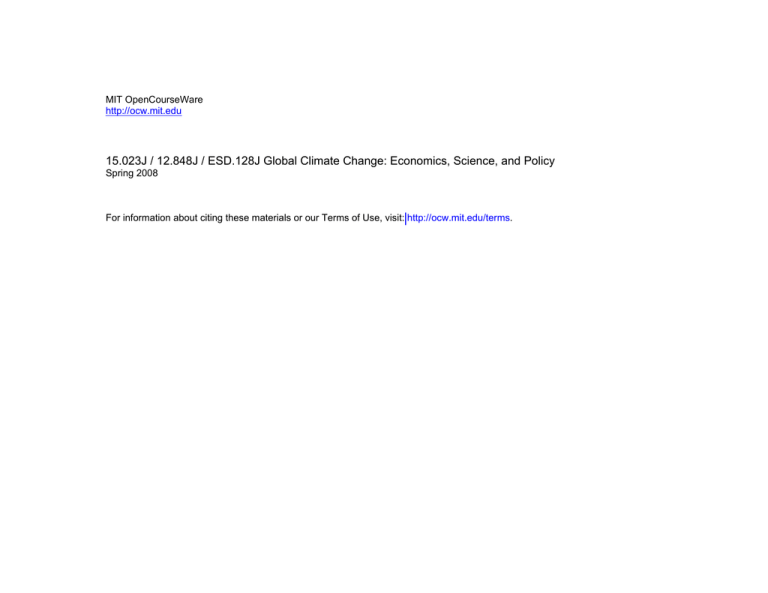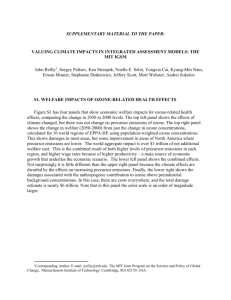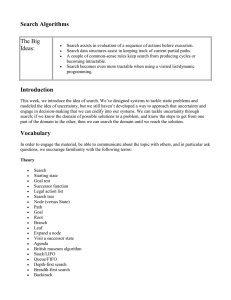15.023J / 12.848J / ESD.128J Global Climate Change: Economics, Science, and... MIT OpenCourseWare Spring 2008 rms of Use, visit:
advertisement

MIT OpenCourseWare http://ocw.mit.edu 15.023J / 12.848J / ESD.128J Global Climate Change: Economics, Science, and Policy Spring 2008 For information about citing these materials or our Terms of Use, visit: http://ocw.mit.edu/terms. 15.023 - 12.848 - 12.308 - ESD.128 GLOBAL CLIMATE CHANGE : ECONOMICS, SCIENCE, AND POLICY THE CLIMATE MACHINE V: INTEGRATED ASSESSMENT I Sensitivity Studies and Uncertainty Analysis using the Integrated Global System Model R. PRINN, April 14, 2008 1. 2. 3. 4. 5. Structural & Parametric Uncertainty Sensitivity Analysis Uncertainty Analysis: IGSM 1 Uncertainty Analysis: IGSM 2.2 Communicating Uncertainty TWO TYPES OF UNCERTAINTY STRUCTURAL UNCERTAINTY PARAMETRIC UNCERTAINTY TWO TYPES OF ANALYSIS SENSITIVITY UNCERTAINTY Sensitivity Analysis using the MIT INTEGRATED GLOBAL SYSTEM MODEL VERSION 1 Anthropogenic emissions prediction and policy analysis model Agricultural production 12 regions Natural emissions model 1' x 1' 2.5' x 2.5' CO2, CH4, N2O, NOx, SOx, CO, CFCs, CH4 N2O Ocean CO2 uptake Soil C Soil N Temperature Rainfall Nutrients, pollutants Coupled Atmospheric chemistry and climate model Sea level Land CO2 uptake 2D land-ocean (7.8' x 9 levels) Temperature, Rainfall, clouds, CO2 Land vegetation change Terrestrial ecosystems model 0.5' x 0.5' Figure by MIT OpenCourseWare. Ref: Prinn et al, Climatic Change, 41, 469-546, 1999 SENSITIVITY ANALYSIS: Defining the uncertain parameters Image removed due to copyright restrictions. See Table IV in: Prinn, R., et al. "Integrated Global System Model for Climate Policy Assessment: Feedbacks and Sensitivity Studies." Climatic Change 41, no. 3/4 (1999): 469-546. Schematic illustrating the seven runs performed for the Sensitivity Analysis of the IGSM 1. Open ellipses denote points in sequence where output is available, with the letters in the ellipse denoting the identifying symbol for the output. Cooler Runs Warmer Runs EPPA model [p, e, b] Lower L Coupled Chemistry/ Climate/ Ocean carbon model NEM model R Emissions H [K, a] Faster Slower Lower Higher Higher Lower Faster Slower Lower Higher Higher Lower Ocean uptake Warming rate Aerosol O.D. [S] Lower Higher TEM model Higher LLL LLL LLH Higher LHH Lower R HLL Lower Higher HHL LLH R HHL LLH R HHL Sensitivity HHH HHH Figure by MIT OpenCourseWare. Ref: Prinn et al, Climatic Change, 41, 469-546, 1999 Sensitivity of Temperature Change from 1990 to 2100 to assumed: Emissions (p, e, b); Ocean Heat & Carbon Uptake and Aerosol Forcing (K, a); & Climate Sensitivity (s) 10.0 Degrees centigrade 8.0 HHH LHH 6.0 HHL RRR 4.0 HLL LLL LLH 2.0 0.0 90 North 60 30 0 -30 -60 Latitude Figure by MIT OpenCourseWare. -90 South Figure by MIT OpenCourseWare. Ref: Prinn et al, Climatic Change, 41, 469-546, 1999 Uncertainty Analysis using the MIT INTEGRATED GLOBAL SYSTEM MODEL VERSION 1 THE MAJOR CLIMATE FORECAST MODEL UNCERTAINTIES INVOLVE CLOUDS, OCEAN MIXING & AEROSOL FORCING. TO ESTIMATE THE PDFs OF VARIOUS MEASURES OF CLIMATE CHANGE, WE USE VERY LARGE THESE UNCERTAINTIES ARE ENSEMBLES OF IGSM CONSTRAINED BY RUNS ,EACH WITH OBSERVATIONS RANDOMLY CHOSEN EQUAL PROBABILITY ADDED TO THESE CHOICES FOR THE ARE SUBSTANTIAL UNCERTAIN MODEL UNCERTAINTIES PARAMETERS. IN EMISSION FORECASTING Uncertainty Analysis Method • 250 runs of the MIT IGSM with Latin hypercube sampling of uncertain model parameters • No explicit policy and stringent policy (at or below 550ppm CO2 equivalent) cases • Policy should lower probability of damaging outcomes TO ADDRESS UNCERTAINTY MIT CLIMATE MODEL HAS FLEXIBLE SENSITIVITY, OCEAN MIXING & AEROSOL FORCING WHOSE UNCERTAINTIES ARE CONSTRAINED BY OBSERVATIONS Images removed due to copyright restrictions. See Figure 4 in: Forest, Chris, et al. "Quantifying Uncertainties in Climate System Properties with the Use of Recent Climate Observations." Science 295 (2002): 113-117. 1200 1000 x 800 Mean +/-S tandard Deviation 95% Probability Bounds IPCC SRES Scenarios 600 400 x PROBABILITY RANGES FOR NO-POLICY CASE OF EMISSIONS OF SELECTED CLIMATEFORCING & POLLUTING GASES (EPPA cf. SRES) 200 0 1990 2000 2010 2020 2030 2040 2050 2060 2070 2080 2090 2100 Year Global CO2 Emissions (PgC/yr) Global NOx Emissions (Tg/yr) CO2 Emissions (Gt C) 50 40 30 Mean +/-S tandard Deviation 95%P robability Bounds IPCC SRES Scenarios 20 10 0 1990 2000 2010 2020 2030 2040 2050 2060 2070 2080 2090 2100 Year Ref: Webster et al, Atmos. Environ.,2002 Global SO2 Emissions (Tg/yr) Courtesy Elsevier, Inc., http://www.sciencedirect.com. Used with permission. Projected changes in atmospheric CO2 concentrations relative to 1990. Solid lines show the lower 95%, median, and upper 95% in the absence of greenhouse gas restrictions, and dashed lines show the lower 95%, median, and upper 95% under a policy that approximately stabilizes CO2 concentrations at 550 ppm. Source: Webster et al., Climatic Change, 2003 (MIT JPSPGC Report No. 95) Projected changes in radiative forcing relative to 1990 due to all greenhouse gases. Solid lines show the lower 95%, median, and upper 95% in the absence of greenhouse gas restrictions, and dashed lines show the lower 95%, median, and upper 95% under a policy that approximately stabilizes CO2 concentrations at 550 ppm. Source: Webster et al., Climatic Change, 2003 (MIT JPSPGC Report No. 95) Projected changes in global mean surface temperature relative to 1990. Solid lines show the lower 95%, median, and upper 95% in the absence of greenhouse gas restrictions, and dashed lines show the lower 95%, median, and upper 95% under a policy that approximately stabilizes CO2 concentrations at 550 ppm. Source: Webster et al., Climatic Change, 2003 (MIT JPSPGC Report No. 95) FULL PDF’S OF KEY MEASURES OF CLIMATE CHANGE for 1990-2100, WITH & WITHOUT the (550 ppm) POLICY POLICY LOWERS PROBABILITY OF DANGEROUS AMOUNTS OF WARMING Source: Webster et al., Climatic Change, 2003 (MIT JPSPGC Report No. 95) POLICY LOWERS PROBABILITY OF DANGEROUS AMOUNT OF SEA LEVEL RISE INFLUENCE OF EMISSIONS VS. CLIMATE ON THE PDF’s HUMAN AND NATURAL COMPONENTS CONTRIBUTE SIMILARLY TO TOTAL UNCERTAINTY Probability distributions of global mean surface temperature change from 1990 to 2100 from all uncertain parameters (solid blue), only climate model parameters uncertain and emissions fixed (dotted red), and only emissions uncertain with climate model parameters fixed (dashed green). Source: Webster et al., Climatic Change, 2003 (MIT JPSPGC Report No. 95) WHAT IS THE PROBABILITY OF VARIOUS AMOUNTS OF CLIMATE CHANGE BY LATITUDE for 1990-2100, WITH & WITHOUT A ( 550 ppm CO2-equivalent ) POLICY? HIGH LATITUDES ARE AT GREATEST RISK 1/40 1/2 1/40 Antarctic Arctic Projected change in surface warming by latitude band between 1990 and 2100. The median value, and lower 95% and upper 95% bounds are shown. Solid lines show distributions resulting from no emissions restrictions and dashed lines are distributions under the sample policy. Source: Webster et al., Climatic Change, 2003 (MIT JPSPGC Report No. 95) Uncertainty Analysis of MIT IGSM 2.2 under No Policy and Stabilization Scenarios Ref: Sokolov, Forest, et al, 2008 and Webster et al, 2008, Joint Program, in preparation Methodology • Estimate probability distributions for input parameters controlling the emissions and climate projections-system models (1) Emissions Uncertainties (2) Climate System Response Uncertainties: Climate Sensitivity Rate of Heat uptake by Deep Ocean Radiative Forcing Strength of Aerosols (3) Greenhouse Gas Cycle Uncertainties: CO2 Fertilization Effect on Ecosystem Sink Rate of Carbon Uptake by Deep-Ocean Trends in Rainfall Frequency on CH4 + N2O • Generate 400 member ensembles to represent Monte Carlo sample • Simulate Reference (i.e., No Policy) and Four Stabilization Scenarios (450, 550, 650, and 750 ppm) Ref: Sokolov, Forest, et al, 2008 and Webster et al, 2008, Joint Program, in preparation Ref: Forest, et al, 2008 Main features of joint PDF from re-calibrated IGSM2 climate model component: Positions of mode/median occur for lower rates of ocean heat uptake. Effective Climate Sensitivity (C) Expert priors on CS are required for upper bound but NOT for lower bound. 10 IPCC AR4 models (and 5 TAR models) cover only a portion of acceptable parameter space. Main Implication: Lower Kv Æ less ocean heat and C uptake and faster warming, but slower sea level rise Rate of Ocean Mixing (Rate of Deep-ocean Heat & C Uptake) (Kv, sqrt[cm2/s]) Frequency (# per 0.25 oC) Frequency Distributions for Temperature Change from 2000 to 2100 under No Policy and 4 CCSP Stabilization Scenarios CO2 (ppm) No Policy Median ~ 850 ppm 2.5-97.5% ~ 630-1265ppm Ref: Sokolov, Forest, et al, 2008 and Webster et al, 2008, Joint Program, in preparation COMMUNICATING UNCERTAINTY AND RISK Risks of Global Mean Temperature Increase Since Preindustrial ΔT > 2oC ΔT > 4oC ΔT > 6oC No Policy 400 in 400 4 in 5 1 in 3 Stabilize at 750 400 in 400 3 in 5 1 in 50 Stabilize at 650 98 in 100 1 in 5 1 in 200 Stabilize at 550 97 in 100 1 in 20 <1 in 400 Stabilize at 450 70 in 100 <1 in 400 <1 in 400 Ref: Sokolov, Forest, et al, 2008 and Webster et al, 2008, Joint Program, in preparation COMMUNICATING UNCERTAINTY AND RISK Risks of Ocean Impacts Sea Level Rise > 0.3m Sea Level Rise > 0.6m No Policy 19 in 20 8 in 50 Stabilize at 750 17 in 20 2 in 50 Stabilize at 650 15 in 20 1 in 50 Stabilize at 550 11 in 20 <1 in 400 Stabilize at 450 5 in 20 < 1 in 400 Ref: Sokolov, Forest, et al, 2008 and Webster et al, 2008, Joint Program, in preparation Why is the Reference distribution shifted To higher temperatures? • • • – – – – – – Radiative Forcing Increases? Emissions (higher lower bound) Reduced Ocean Carbon Uptake Additional forcing such as Black Carbon & Tropospheric Ozone (additional forcing included but still calibrated by net aerosols in 1990s) Climate Model Response? Climate Model Parameters show higher response Learning? Distributions better defined Distributions shifted higher Ref: Sokolov, Forest, et al, 2008 and Webster et al, 2008, Joint Program, in preparation Conclusions regarding odds of Future Climate Change from latest Analysis – ΔT > 2oK above pre-industrial • virtually certain under No Policy scenario • reduced to 7 in 10 chance with 450 ppm stabilization – ΔSeaLevel > 0.3 meters above pre-industrial • 19 chances in 20 under No Policy scenario • reduced to 1 in 4 chance with 450 ppm stabilization Ref: Sokolov, Forest, et al, 2008 and Webster et al, 2008, Joint Program, in preparation Concluding Remarks As with all investigations of complex and only partially understood systems the probability results must be treated with appropriate caution: • Current knowledge of stability of great ice sheets, stability of thermo-haline circulation, ecosystem dynamics, climate-severe storm connections, future technological innovation, human population dynamics, political change, etc., is limited. • Therefore, “surprises” not currently evident from model studies including uncertainty studies may occur.



